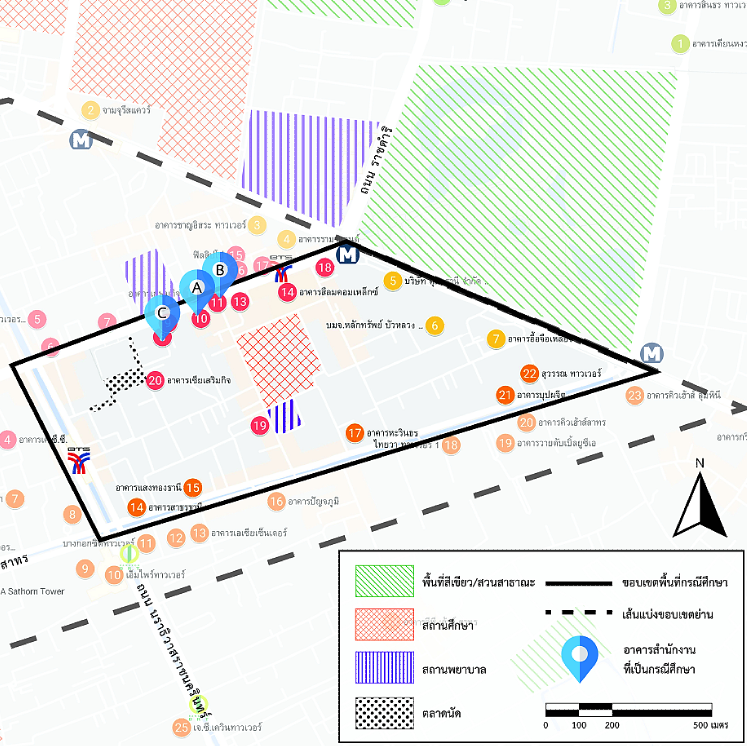Active Design and Physical Activity of Office Worker in Public Space
Main Article Content
Abstract
Lacking physical activity can cause risks of Non-Communicable Diseases (NCDs) on urban residences, particularly in working-age groups who work in the office buildings, leading to premature death. This article aims to study physical factors to promote physical activities in the public space of office buildings, by applying the Active Design concept onto three office buildings in Silom, CBD of Bangkok. The research method employed observation of physical and behavioral data in the public space of the sampled office buildings. The approach to this method was designed to assess the physical activity level of the Silom’s office workers as compared with the adequate standard levels of physical activity. The result revealed that the 318 samples had an average walking distance of 209 meters in 10 minutes, which was four times lower than the adequate levels of physical activity. Two sets of physical factors were found promoting the levels of physical activities in office buildings, including: 1) direct factors such as urban rail transit, feeder network, mixed land use and quality of pedestrian and building surroundings. 2) indirect factors which contribute to social interaction, such as pocket space of building surroundings, the sequence of transition space levels between the office building and public space. Both sets of factors work together to create a lively environment and more opportunities for daily physical activity. The contribution of the research findings will be useful to professional and academic practices in health and well-being concerns in architecture and urban design.
Downloads
Article Details

This work is licensed under a Creative Commons Attribution-NonCommercial-NoDerivatives 4.0 International License.
All material is licensed under the terms of the Creative Commons Attribution 4.0 International (CC-BY-NC-ND 4.0) License, unless otherwise stated. As such, authors are free to share, copy, and redistribute the material in any medium or format. The authors must give appropriate credit, provide a link to the license, and indicate if changes were made. The authors may do so in any reasonable manner, but not in any way that suggests the licensor endorses you or your use. The authors may not use the material for commercial purposes. If the authors remix, transform, or build upon the material, they may not distribute the modified material, unless permission is obtained from JARS. Final, accepted versions of the paper may be posted on third party repositories, provided appropriate acknowledgement to the original source is clearly noted.
References
BETA. (2016). Active Design in Building. City of Amsterdam.
Charoenyingpaisal, V., & Santad, C. (2018). Study of Active Design Factors to Promote Physical Activities of Workers in Office Building. The 9th Built Environment Research Associates Conference 2018 (BERAC 9),70-79.
Gehl, J. (2013). The Book Critics of Life Buildings: Using Public Space by Jan Gehl. (P. S. Rungsang, Trans.) Bangkok: li-zenn publishing limited.
IPSR (Institute for Population and Social Research). (2015). Development of a Surveillance System for Physical Activity Behavior of Thai Population. Retrieved September 18, 2017 from http://www.ipsr.mahidol.ac.th
IWBI (International WELL Building Institute). (2017). WELL Building Standard. Retrieved December 6, 2017 from https://www.wellcertified.com
Jacob, J. (1961). The Death and Life of Great American Cities. New York.
Nimitnaradol, P. (2010). Facility programming guidelines of support business sector in a large private organization for a healthy workplace. (Master’s thesis). Thammasat University, Faculty of Architecture and Planning.
Santad, C. (2005). The Guidelines for Public Space Improvement of Thammasat University, Tha-prachan Campus: Spatial and Movement Network Analysis. Journal of Architectural/Planning Research and Studies (JARS), 3,209-224.
Thai Health Promotion Foundation. (2017). Thaihealth Master Plan 2018-2020. Retrieved from https://www.thaihealth.or.th
UddC. (2015). Good Walk. Retrieved September 18, 2017 from Urban Design & Development Center: http://www.uddc.net
WBDG. (2016). DESIGN FOR THE CHANGING WORKPLACE. Retrieved November 19, 2017 from WBDG Whole Building Design Guide: https://www.wbdg.org/design-objectives/productive/provide-comfortable-environments
WHO. (2017). Health topics: Physical activity. Retrieved October 3, 2017 from http://www.who.int/topics/physical_activity
WHO. (2018). Noncommunicable diseases. Retrieved February 1, 2018 from World Health Organization: http://www.who.int/mediacentre/factsheets/fs355/en/
Zimring, C., Joseph, A., Nicoll, G. L., & Tsepas, S. (2005). Influences of building design and site design on physical activity: Research and intervention opportunities. American Journal of Preventive Medicine, 28(2), 186-193.


